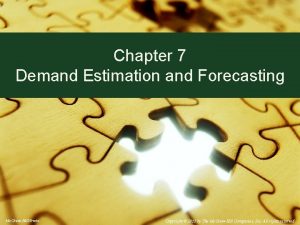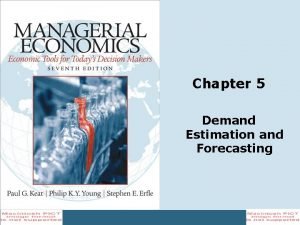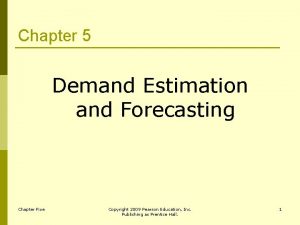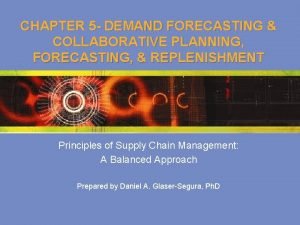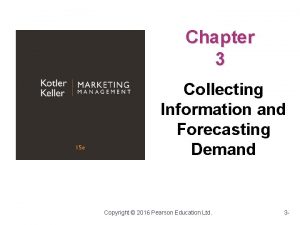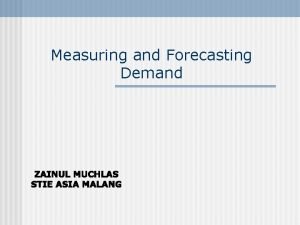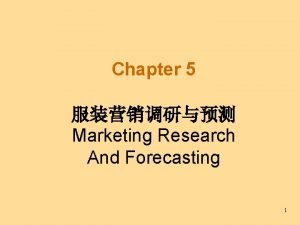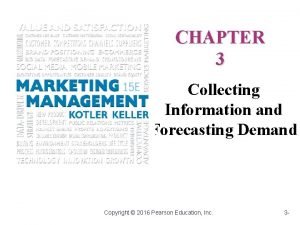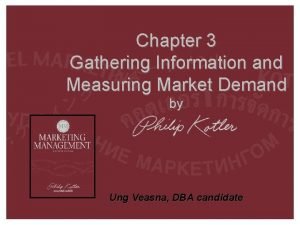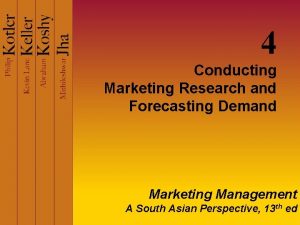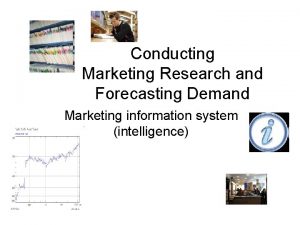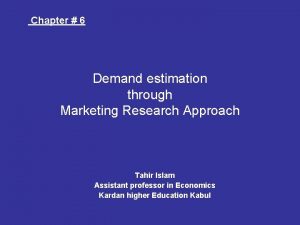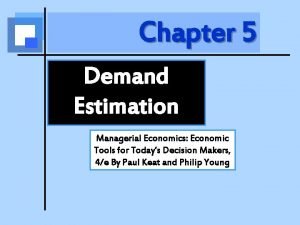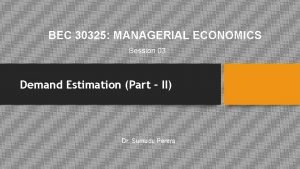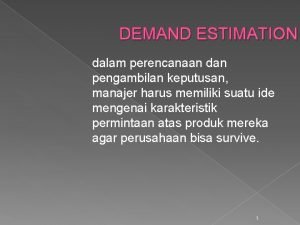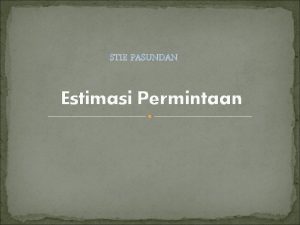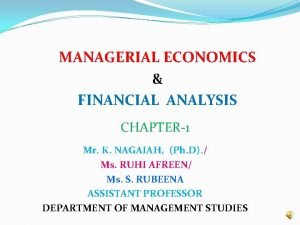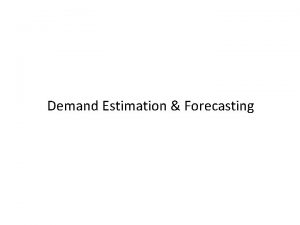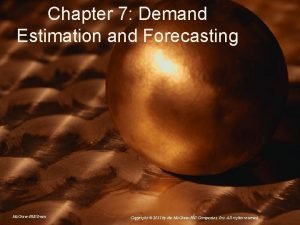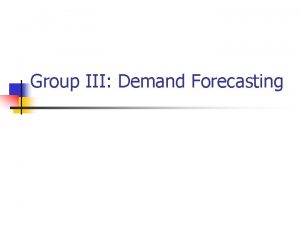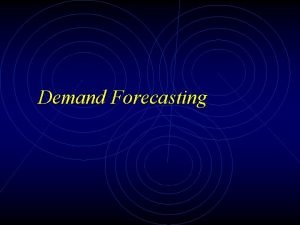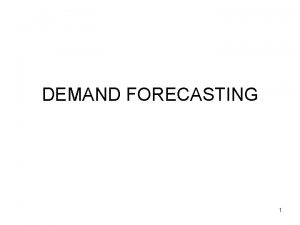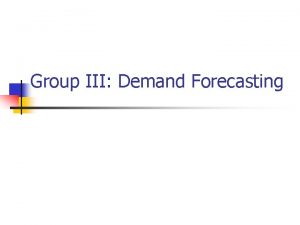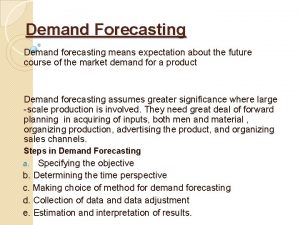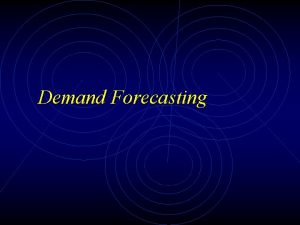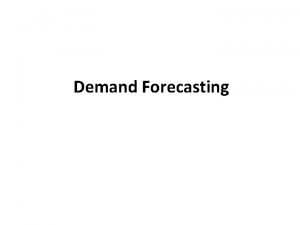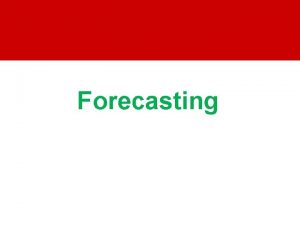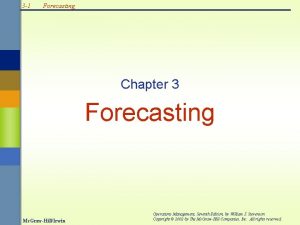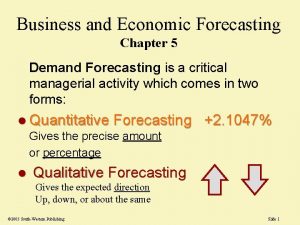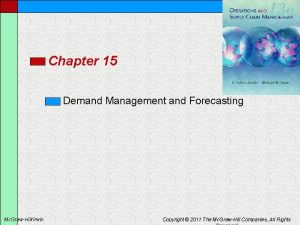Chapter 7 Demand Estimation and Forecasting Mc GrawHillIrwin























- Slides: 23

Chapter 7 Demand Estimation and Forecasting Mc. Graw-Hill/Irwin Copyright © 2013 by The Mc. Graw-Hill Companies, Inc. All rights reserved.

Learning Objectives v Explain strengths and weaknesses of direct methods of demand estimation v Specify an empirical demand function v Employ linear regression methodology to estimate the demand function for a single price-setting firm v Forecast sales and prices using time-series regression analysis v Use dummy variables in time-series demand analysis to account for cyclical or seasonal variation in sales v Discuss and explain several important problems that arise when using statistical methods to forecast demand 7 -2

Direct Methods of Demand Estimation v Consumer interviews ~ Range from stopping shoppers to speak with them to administering detailed questionnaires 7 -3

Direct Methods of Demand Estimation v Potential problems with consumer interviews ~ Selection of a representative sample, which is a sample (usually random) having characteristics that accurately reflect the population as a whole ~ Response bias, which is the difference between responses given by an individual to a hypothetical question and the action the individual takes when the situation actually occurs ~ Inability of the respondent to answer accurately 7 -4

Direct Methods of Demand Estimation v Market studies & experiments ~ Market studies attempt to hold everything constant during the study except the price of the good ~ Lab experiments use volunteers to simulate actual buying conditions ~ Field experiments observe actual behavior of consumers 7 -5

Empirical Demand Functions v Demand equations derived from actual market data v Useful in making pricing & production decisions 7 -6

Empirical Demand Functions v In linear form, an empirical demand function can be specified as where Q is quantity demanded, P is the price of the good or service, M is consumer income, PR is the price of some related good R, and N is the number of buyers 7 -7

Empirical Demand Functions v In linear form ~ b = Q/ P ~ c = Q/ M ~ d = Q/ PR v Expected signs of coefficients ~ b is expected to be negative ~ c is positive for normal goods; negative for inferior goods ~ d is positive for substitutes; negative for complements 7 -8

Empirical Demand Functions v Estimated elasticities of demand are computed as 7 -9

Nonlinear Empirical Demand Specification v When demand is specified in log-linear form, the demand function can be written as v To estimate a log-linear demand function, covert to logarithms v In this form, elasticities are constant 7 -10

Demand for a Price-Setter v To estimate demand function for a pricesetting firm: ~ Step 1: Specify price-setting firm’s demand function ~ Step 2: Collect data for the variables in the firm’s demand function ~ Step 3: Estimate firm’s demand 7 -11

Time-Series Forecasts v A time-series model shows how a timeordered sequence of observations on a variable is generated v Simplest form is linear trend forecasting ~ Sales in each time period (Qt ) are assumed to be linearly related to time (t) 7 -12

Linear Trend Forecasting v Use regression analysis to estimate values of a and b ~ If b > 0, sales are increasing over time ~ If b < 0, sales are decreasing over time ~ If b = 0, sales are constant over time v Statistical significance of a trend is determined by testing or by examining the p-value for 7 -13

A Linear Trend Forecast (Figure 7. 1) Q Estimated trend line 12 2018 Sales 20137 2018 2013 2012 2011 2010 2009 2008 2007 2006 2005 2004 2003 t 7 -14

Forecasting Sales for Terminator Pest Control (Figure 7. 2) 2013 2013 2013 2014 7 -15

Seasonal (or Cyclical) Variation v Can bias the estimation of parameters in linear trend forecasting v To account for such variation, dummy variables are added to the trend equation ~ Shift trend line up or down depending on the particular seasonal pattern ~ Significance of seasonal behavior determined by using t-test or p-value for the estimated coefficient on the dummy variable 7 -16

Sales with Seasonal Variation (Figure 7. 3) 2010 2011 2012 2013 7 -17

Dummy Variables v To account for N seasonal time periods ~ N – 1 dummy variables are added v Each dummy variable accounts for one seasonal time period ~ Takes value of one (1) for observations that occur during the season assigned to that dummy variable ~ Takes value of zero (0) otherwise 7 -18

Effect of Seasonal Variation (Figure 7. 4) Qt Qt = a′ + bt Sales Qt = a + b t a′ c a t Time 7 -19

Some Final Warnings v The further into the future a forecast is made, the wider is the confidence interval or region of uncertainty v Model misspecification, either by excluding an important variable or by using an inappropriate functional form, reduces reliability of the forecast 7 -20

Some Final Warnings v Forecasts are incapable of predicting sharp changes that occur because of structural changes in the market 7 -21

Summary v Consumer interviews and market studies are two direct methods of demand estimation ~ Problems can include: (1) selection of a representative sample; (2) response bias; and (3) inability of the respondent to answer accurately v Empirical demand functions are demand equations derived from actual market data and are extremely useful in making pricing and production decisions v The first step to estimating a single price-setting firm’s demand is to specify the demand function; the second step is to collect data; the third step is to estimate the parameters using the linear regression 7 -22

Summary v A time-series model shows how a time-ordered sequence of observations on a variable is generated ~ The simplest form of time-series forecasting is linear trend forecasting v Seasonal or cyclical variation can bias results in linear trend models; to account for this, dummy variables are added to the trend equation ~ Dummy variables take a value of 1 for those observations that occur during the season assigned to that dummy variable, and a value of 0 otherwise v When making forecasts, analysts must recognize the limitations that are inherent in forecasting 7 -23
 Methods of demand estimation in managerial economics
Methods of demand estimation in managerial economics Demand estimation and forecasting
Demand estimation and forecasting Demand estimation and forecasting
Demand estimation and forecasting Demand estimation and forecasting
Demand estimation and forecasting Replenishment forecasting
Replenishment forecasting Forecasting and demand measurement
Forecasting and demand measurement Market buildup method
Market buildup method Marketing approach to demand measurement
Marketing approach to demand measurement Forecasting and demand measurement in marketing
Forecasting and demand measurement in marketing Collecting information and forecasting demand
Collecting information and forecasting demand Forecasting and demand measurement in marketing
Forecasting and demand measurement in marketing Marketing research and forecasting demand
Marketing research and forecasting demand Conducting marketing research and forecasting demand
Conducting marketing research and forecasting demand Collecting information and forecasting demand summary
Collecting information and forecasting demand summary Forecasting and demand measurement in marketing
Forecasting and demand measurement in marketing Marketing research approaches to demand estimation
Marketing research approaches to demand estimation Regression analysis in managerial economics
Regression analysis in managerial economics Demand estimation in managerial economics
Demand estimation in managerial economics Demand estimation
Demand estimation Contoh estimasi permintaan
Contoh estimasi permintaan Module 5 supply and demand introduction and demand
Module 5 supply and demand introduction and demand Hotel demand forecasting
Hotel demand forecasting Statistical methods of demand forecasting
Statistical methods of demand forecasting Chain ratio method
Chain ratio method

